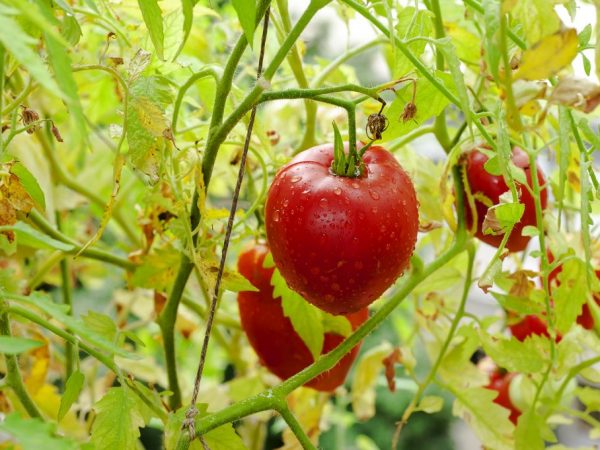Characteristics of the Eagle's Beak tomato
The Eagle's Beak tomato has unusual characteristics that are rarely found in other varieties. Due to the fact that it does not require special care for itself and always gives amazing yield indicators, many farmers and gardeners love it so much.

Characteristics of the Eagle's Beak tomato
Characteristics of the variety
Tomato variety Eagle's beak was bred on the territory of Russia. Several dozen of the most qualified specialists were engaged in the development of this variety. They wanted to create a look that was unlike any other tomato in existence. And they managed to achieve their goal. The type of tomato Eagle's beak was entered in the State Register of the Russian Federation.
Breeders advise planting seedlings in any region of the country, because this variety grows ideally, both in the greenhouse and in the open field. Planting can be done both by ordinary gardeners for their own purposes, and by professional agronomists for sale.
Description of the plant
Characteristics and description of the tomato Eagle's beak suggests that it belongs to the middle early crops. Its growing season is about 100 days. The bush belongs to the indeterminate category, that is, its growth is not limited. The height of the bush can reach several meters.
Average leafiness. Individual leaves are large in shape and have a rich shade of green. Inflorescences are presented in a standard form, that is, the first is formed at the 10-leaf level. All subsequent inflorescences are formed every 3 leaves.
Description of the fetus
Characteristics of the tomato Eagle's beak suggests that the shape of the fruit resembles a heart. A small spout is formed at the ends of the tomatoes, which creates a unique shape. Tomatoes of this variety are large in size, because an individual ripe fruit can be about 600 g.
The pulp is fleshy, not watery. A slight sugar flavor may be present at the break. The description suggests that tomatoes have a small number of seeds, which are located in 6 compartments. Productivity is at a high level. About 15 kg of selected, high quality tomatoes can be harvested from 1 m2. Due to its taste, Eagle's Beak tomatoes are suitable not only for fresh consumption. It is in the form of preservation or pickles that they show all their qualities of taste.
Advantages and disadvantages
A number of positive features should be highlighted:
- high yield rates;
- good characteristics of taste and commercial quality;
- high rates of immunity in relation to most diseases;
- versatility in use and preparation.

The fruits can be consumed in any form
The Eagle's Beak tomato also has a drawback. It consists in the fact that the bush must be tied up. It is also important to pay attention to timely care, because the yield of tomatoes depends on this.
Growing process
First of all, you need to plant seeds in a greenhouse to get seedlings. Planting takes place in early April. Tomatoes are demanding on the soil. Therefore, preference should be given to the land that contains a large amount of humus. You can also add humus yourself. In this case, any soil will do. It is very important to treat the seeds with growth stimulants. After that, the seeds are planted in special containers, to a depth of about 2 cm.
Planting seedlings in greenhouses takes place in the month of May. But in open ground, it should be planted in mid-June, because it is very important that the soil warms up to a temperature of 15-18 ° C. Before landing, you should add 1 tbsp to each hole. l. potassium and phosphorus compounds. Reviews of the tomato Eagle's beak suggests that vegetables will germinate well if the planting depth of seedlings does not exceed 3 cm. Gardeners have the opinion that a distance of 50 cm should be kept between the rows, but between the holes it should be 35 cm.
Requirements for proper care
These tomatoes do not require unusual maintenance. They should be looked after in a standard way. But leaving must be timely. First, good watering is important. It should be carried out in the evening and exclusively with water at room temperature. The root system should not be allowed to freeze. Watering is carried out by drip method, and once a week. Top dressing includes a combination of organic matter and mineral fertilizers. It is very important to alternate them with each other.
In mineral fertilizers, potassium, phosphorus and nitrogen compounds should prevail. Do not forget about the timely loosening of the soil, removing all weeds, weeding the beds and hilling the root system. What the tomatoes will look like in the future depends on this.
Prophylaxis
Despite the fact that these tomatoes are resistant to a large number of diseases, preventive measures will never be superfluous. To protect the yield from the invasion of fungal diseases, phytosporin should be used. You can also use a weak manganese solution. If there is a risk of late blight, then the use of drugs with a high copper content is recommended.
To protect yields from pests and parasites, folk remedies are used. They consist in using soapy water, ammonia solution, chamomile or onion decoction. Do not forget about regular airing of the greenhouse.
Conclusion
If you decide to grow high-yielding varieties of tomatoes, then you should pay attention to the Eagle's Beak. It is he who will allow you to be sure that the harvest will be at the highest level. The main thing is to follow all the rules for planting and caring. And then the result will not be long in coming.


